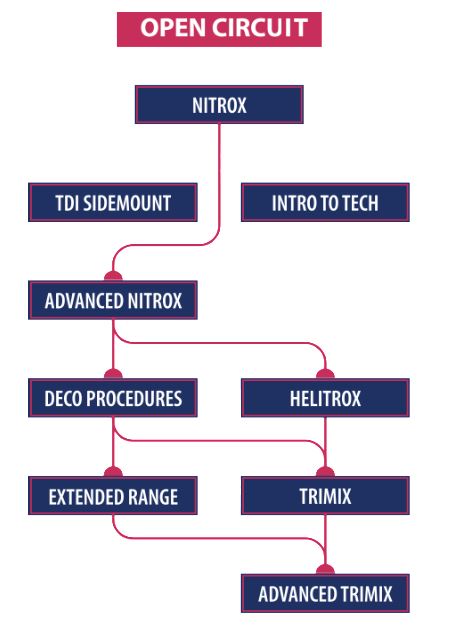The rebreather – a device accessible to everyone! This machine is not reserved for the elite: all you need is to be properly trained and to be rigorous in applying the rules, and you will open un-hoped for horizons. Rebreather diving is becoming more and more popular – at the latest diving exhibition in Paris there were rebreathers everywhere !
With a rebreather, you breathe calmly through a closed air circuit, which gives you 6 major advantages :
No bubbles, so no noise, you are really in a “world of silence”, which means you can approach the fish in a truly amazing way ;
No more problems of air autonomy – the machine simply completes the oxygen you use, which means you can dive with over 4 hours of autonomy !
Most important of all, the rebreather produces the mix of air you need as you go along, so that the safety stops are absolutely optimised. It is as if you had, when coming back up, dozens of different nitrox mixes (going as far as pure oxygen) to optimise decompression. Not something to be sniffed at!
The air you breathe is warm and moist, which is much pleasanter and avoids considerable loss of heat.
For “deep” divers, the rebreather means a huge saving in gas, and given the high price of helium, this is a considerable advantage and can cut the cost of a dive by 10!!
For demanding dives, it avoids you carrying a ludicrous amount of tanks with you during the dive.
Here is a concrete example: during a 40 meter dive using an “open circuit” (standard tanks) and with a ascent time of 15 minutes, you can stay down at maximum depth no longer than 20 minutes – if your air consumption allows you even that! With a rebreather, you can enjoy the maximum depth for almost 45 minutes, without increasing the ascent time.
Rebreather training comprises 8 dives of at least one hour. The machine used is the Triton mccr. This rebreather is a machine designed for manual management of your oxygen supply. During your training you will learn to adjust your weight-belt and your position in the water. You will also cover the recommended reactions in case of a problem: oxygen failure, drowning of the buckle … The rebreather is reliable since it offers multiple systems. In the case of a failure, a malfunction or simply if you are in doubt, there is always a solution.
You will work on the “what if…”: what do I do if this or that happens.
To move onto even deeper dives, you will need to pass the “Normoxic Trimix Diver” qualification to go down to 70 metres, or the “Hypoxic Trimix Diver” to go down to 100m.
Why use the Triton rebreather?
– First of all, the price, not a negligible factor in view of the price of these devices.
– The size : the triton rebreather is very compact, you can carry it on board with you as hand luggage in the plane, which is reassuring as you eliminate the lost luggage risk.
– Its simplicity : it is mechanic rather than electronic which means less risk of failure, fewer problems, less maintenance, fewer parts to change, less manipulation.
– Security : you are the one who controls your O2%, not an electronic machine.
– Straightforward and robust: for those who travel with their equipment or who live in remote areas, this factor is also important.
– For demanding dives, the triton is a ventral rebreather, which means you can comfortably carry another one on your back.
– The weight and siza of the device when diving – very comfortable!
– It can be used with your BCD, you tank, which can be reduced down to 6l, is then used to supply the rebreather (as a diluter) and as a bail-out tank.
– You will be able to move in the future towards a Sidemount configuration in order to lighten your configuration.
– If you go in for more demanding dives, the lightweight ventral Triton will fix onto your back harness and will connect up to your other tank, which acts as a diluter and bail-out. The Triton itself is supplied with oxygen through a small aluminium 1.5 litre tank.
– This configuration opens up a whole range of possibilities in terms of dive time, and also in terms of doubling up, thereby improving security.











